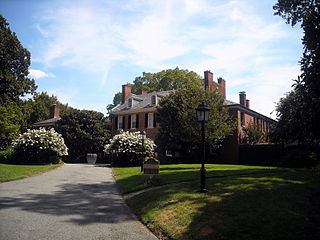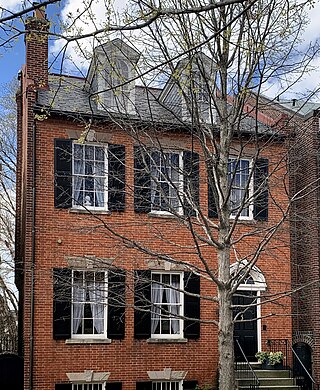
Georgetown is a historic neighborhood and commercial district in Northwest Washington, D.C., situated along the Potomac River. Founded in 1751 as part of the colonial-era Province of Maryland, Georgetown predated the establishment of Washington, D.C. by 40 years. Georgetown was an independent municipality until 1871 when the United States Congress created a new consolidated government for the entire District of Columbia. A separate act, passed in 1895, repealed Georgetown's remaining local ordinances and renamed Georgetown's streets to conform with those in Washington, D.C.

Benjamin Stoddert was the first United States Secretary of the Navy from 1 May 1798 to 31 March 1801.

Chesterfield, originally known as Recklesstown, is an unincorporated community located around the intersection of County Route 528 and County Route 677 in Chesterfield Township of Burlington County, New Jersey.

Uriah Forrest was an American statesman and military leader from Maryland. Forrest was born in St. Mary's County in the Province of Maryland, near Leonardtown. In his early childhood, he received only limited schooling. Born into a family with three other brothers, he was the direct descendant of a person who came to Jamestown, Virginia, in 1608.

This is intended to be a complete list of properties and districts listed on the National Register of Historic Places in Orleans County, New York. The locations of National Register properties and districts may be seen in a map by clicking on "Map of all coordinates". Two listings, the New York State Barge Canal and the Cobblestone Historic District, are further designated a National Historic Landmark.

Halcyon House is a Federal-style home in Washington, D.C. Located in the heart of Georgetown, the house was built beginning in 1787 by the first Secretary of the Navy, Benjamin Stoddert. Its gardens were designed by Pierre L'Enfant, and for several decades in the early 19th century Halcyon House was the center of much of Washington's social life.

Pleasant Home, also known as the John Farson House, is a historic home located in the Chicago suburb of Oak Park, Illinois, United States. The large, Prairie style mansion was designed by architect George Washington Maher and completed in 1897. The house was added to the U.S. National Register of Historic Places on June 19, 1972. Exactly 24 years later, in 1996, it was declared a National Historic Landmark by the United States Department of the Interior.

The Old Stone House is one of the oldest structures in Washington, D.C. The house is also the last pre-revolutionary colonial building in Washington, D.C. Built in 1765, Old Stone House is located at 3051 M Street, Northwest in the city's Georgetown neighborhood. Sentimental local folklore preserved the Old Stone House from being demolished, unlike many colonial homes in the area that were replaced by redevelopment.

Oakwood Cemetery is a nonsectarian rural cemetery in northeastern Troy, New York, United States. It operates under the direction of the Troy Cemetery Association, a non-profit board of directors that deals strictly with the operation of the cemetery. It was established in 1848 in response to the growing rural cemetery movement in New England and went into service in 1850. The cemetery was designed by architect John C. Sidney and underwent its greatest development in the late 19th century under superintendent John Boetcher, who incorporated rare foliage and a clear landscape design strategy. Oakwood was the fourth rural cemetery opened in New York and its governing body was the first rural cemetery association created in the state.

The Shropshire House is a Greek Revival Federal style house located in the East Main Street Residential Historic District in Georgetown, Kentucky. The house was the built in 1814 by John and Mary (Gano) Buckner. The property was added to the U.S. National Register of Historic Places on April 2, 1973.

The Hawkins House, also known as the Cantrill House, is a historic building on East Jackson Street in Georgetown, Kentucky. The structure has been used as a ropewalk, a dormitory for women at Georgetown Female Seminary, and a residential dwelling. During the past 180 years, Georgetown College has bought and sold the property three times. The property was added to the U.S. National Register of Historic Places on April 2, 1973.

This is a list of the National Register of Historic Places listings in Georgetown County, South Carolina.

Holt House is an historic house, located on the grounds of the National Zoo in Washington, D.C. Thought to have been built before 1814, it is one of the most important examples of early Neoclassical architecture in the city, and was one of the major houses in the new national capital when it was built. Since 1889, its caretaker has been the Smithsonian Institution. It is the oldest building under the Smithsonian's management, but has been left vacant since the 1980s.

The Grant Boyhood Home is a historic house museum at 219 East Grant Avenue in Georgetown, Ohio. Built in 1823, it was where United States President and American Civil War General Ulysses S. Grant (1822–85) lived from 1823 until 1839, when he left for the United States Military Academy at West Point. In 1976, the house was listed on the National Register of Historic Places. Nine years later, it was designated a National Historic Landmark. It is now owned by a local nonprofit organization as part of a suite of Grant-related museum properties in Georgetown.

The Hiller Building, also known as the Schick Apartments, is located on the edge of downtown Davenport, Iowa, United States. The Federal style building is a row house. It was individually listed on the National Register of Historic Places in 1974. In 1983 it was included as a contributing property in the West Third Street Historic District.

Oliver Johnson's Woods is a historic district and neighborhood on the northern side of Indianapolis, Indiana, United States. Located in southern Washington Township, the district occupies the site of what was once the family farm of Oliver Johnson. Born on the present site of the Indiana State Fairgrounds, Johnson grew up in a pioneer family that lived on the edge of the state capital city. Upon attaining adulthood, he bought property a short distance to the west, to which he moved in 1846. Here, he built a larger farmhouse in 1862, and he tilled the soil for most of the rest of his life. As Indianapolis grew northward, it reached the Johnson farm in the early twentieth century; the aged farmer and his sons saw the city's growth as an opportunity for financial gain, and in 1905 they announced the platting of 0.25 square miles (0.65 km2) of their property into individual lots. They chose an advantageous time to sell their property; as the new residents began to build their homes, an interurban railway was built along College Avenue on the district's western side that connected downtown with Broad Ripple. Many prosperous businessmen were attracted by the development's large lots and wooded streets; the city annexed Oliver Johnson's Woods in 1912, and by the outbreak of World War II, the streets were filled with large houses built in a wide variety of architectural styles. These early residents came from many different ethnicities: European immigrants were becoming more prosperous and leaving their ethnic enclaves, and new neighborhoods such as Oliver Johnson's Woods appealed to them. Among the neighborhood's leading residents was a colony of Jews of German descent.

Prospect House is a historic building, located at 3508 Prospect Street, Northwest, Washington, D.C., in the Georgetown neighborhood.

Evermay is a historic Federal architecture-style house at 1623 28th Street, Northwest, Washington, D.C., in the Georgetown neighborhood. The property originally extended south to Q Street, but the other houses were divided from the property.

Isaac Owens House, also known as the Gannt-Williams House or John Walker House, is a historic building located at 2806 N Street NW Washington, D.C., in the Georgetown neighborhood.

The Polk County Homestead and Trust Company Addition Historic District is a nationally recognized historic district located in Des Moines, Iowa, United States. It was listed on the National Register of Historic Places in 2016. At the time of its nomination the district consisted of 86 resources, including 48 contributing buildings, 11 contributing structures, 18 non-contributing buildings, and nine non-contributing structures. The end of the 19th century saw the rise of the Victorian suburbs around Des Moines. This was a period of economic growth for the metropolitan area. The largest of these suburbs was North Des Moines. It was connected to Des Moines by way of three streetcar lines, which added to its attractiveness. Local real estate investors established the Polk County Homestead & Trust Co. to develop the northern portion of North Des Moines in partnership with the Prospect Park Improvement Company.





















